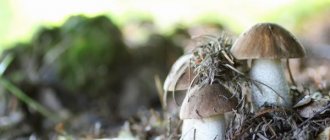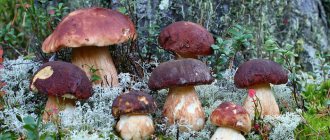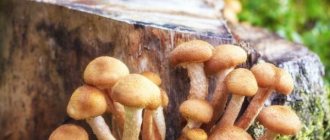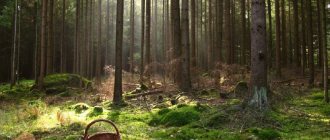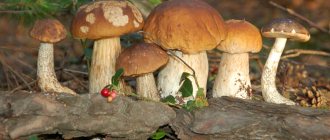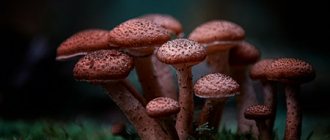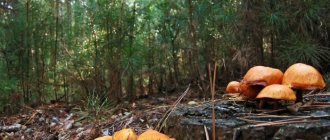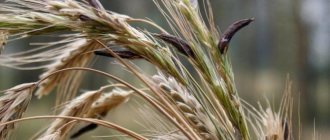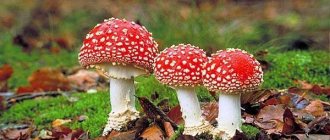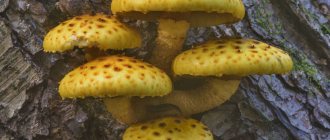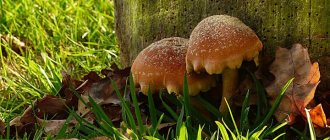Bolethin swamp is considered a conditionally edible mushroom. Residents of foreign countries consider it inedible. It did not gain popularity among amateur mushroom pickers. Because it does not have pronounced taste qualities. If you pickle, then fuss with it no less than with other mushrooms. And it is generally not suitable for fresh consumption due to its bitter taste.
Characteristics of bolethin
Bolethin has a tubular structure. Its body consists of a cap and a stalk.
hat
The hat resembles a pillow in appearance. It has a flat-convex shape with a tubercle in the middle. Its diameter ranges from 5 to 10 cm. Its upper part is dry, but when touched it is velvety and fleshy. The color depends on age: in young people it is bright red, burgundy or cherry, and in old ones the cap begins to lose its brightness and becomes pale and yellowish.
The tubular hymenophore is the part of the submarsh on which the hymenium is located - the layer where spores are stored. It is located at the bottom of the cap. Diverging in the radial direction, the hymenophore can immediately transform into plates. It has a yellow color, gradually turning into brown. The tubular layer descends noticeably onto the stem.
Pulp
The flesh of the marsh grass is colored in a marshy shade, sometimes a barely noticeable blue color can be seen. The taste is clearly bitter. The smell of young boletin is almost imperceptible, but old one smells quite unpleasant.
Leg
The stem is located in the center of the cap, sometimes it can be displaced. Its width is about 2 cm, length – 5-7 cm. The leg looks velvety. The upper part is yellow, the base is thickened. On it you can see the remains of a light red ring.
Habitat
The habitat of meadow mushrooms covers almost all soil and climatic zones of Russia. The most common places:
- meadow;
- pasture;
- summer cottages and garden plots;
- polygon;
- field;
- roadside, etc.
The size and distribution of fungal colonies directly depend on:
- proximity to a body of water;
- the presence of ravines, slopes;
- soil composition;
- vegetation present.
The absence of trees and impenetrable thickets in the area is often used by people for grazing animals. Animals leave behind natural fertilizers and contribute to the spread of fungal spores, which has a beneficial effect on the growth and spread of fungi. Partner plants also enrich the soil with essential nutrients.
Types of boletina mushroom
Let's look at two main types.
Asian boletin (Boletinus asiaticus)
The greatest prevalence is observed in the west and east of Siberia, as well as in the Far East. Mainly grows in deciduous forests. The diameter of the bright red, purple cap reaches 12 cm. The stem is much smaller than the length of the cap. The season falls on August-September.
Boletinus cavipes
The cap of the moth is even larger - 17 cm. The color of the mushrooms is yellow, rusty-red. The immediate distribution area is cedar and deciduous forests. It is collected from August to October.
Mushroom places in central Russia
The nature of the forests where mushrooms grow and the specific places in them are described above.
Among the geographical regions, let us highlight, for example, the mushroom-rich Voronezh, Vladimir, Ryazan, Kaluga, Kursk, Moscow, Nizhny Novgorod and Tver regions.
A separate book could be written on the “mushroom” content of each of them.
Voronezh region and Voronezh
Not only in the Moscow region, but also in the Voronezh region, located in the central part of Russia, you can collect a treasure trove of edible mushrooms. Noble and conventional species sprout in forest areas along with inedible and poisonous fruits that are dangerous to human health and life.
Today, more than 850 species of mushrooms grow in the region. And only a small part of them is known to amateurs. Due to the large fruiting, it is not difficult to encounter common species. However, if an edible mushroom has false brothers, before going into the forest, it is recommended to study the distinctive features that demonstrate the difference between similar forest gifts. Photos and videos will allow you to quickly remember the difference after seeing the clearly described characteristics.
Despite the large fruiting, it is impossible to detect all types of mushrooms at once. Each species germinates at a certain time of year and even month. For example, the honey mushroom family bears fruit almost all year round, thanks to its varieties. From mid-spring, meadow mushrooms begin to bear fruit, followed by Assumption, autumn and royal mushrooms. In winter, provided the weather is warm, you can find flammulina or winter honey fungus growing on trees and stumps. The reddish color of the mushrooms will highlight the fruits among the snowy landscape, making the harvest visible to the naked eye.
When going on a quiet hunt in September 2022, you will be able to collect mushrooms of the following species:
- boletus;
- saffron milk caps;
- Russula;
- rows;
- honey mushrooms (most often you can find the following: autumn, royal, Assumption, summer);
- hygrophores or spruce mushrooms;
- white and Polish mushroom;
- boletuses (boletus and boletus);
- flywheels;
- chanterelles;
- waves;
- Bluelegs.
The best places for picking mushrooms in the Voronezh region are:
- McLock;
- Borovoe;
- New Usman;
- Maslovka;
- Alekseevsky Gardens;
- the airport area behind the shopping mall;
- Honey cake;
- Novozhivotinnoe.
Classification
In the classification of all mycoses, the following lesions are distinguished:
- Superficial ( dermatomycosis ).
- Deep subcutaneous lesions.
- Visceral mycoses (damage to internal organs).
Superficial mycoses are classified according to the localization of the process:
- Mycosis of the feet.
- Smooth skin of the body.
- Inguinal mycosis.
- The scalp.
- Mycosis of the hands.
- Onychomycosis (damage to nails).
- Mycosis of the face.
Facial dermatophytosis is most often found in countries with warm climates. There are two forms: classic and with deep inflammatory lesions. In the first form, the lesion is represented by flat scaly papules, the borders of which are raised and enlarged, turning into a ring-shaped lesion. The desquamation border contains elevated papules and vesicles. The merged elements occupy large areas.
Deep lesions are caused by the fungus Trichophyton verrucosum, which is transmitted from cattle. Large inflammatory foci with a raised surface and pustules appear on the skin of the face. A secondary bacterial (staphylococcal) infection is often associated. The process resolves with hyperpigmentation and scarring .
Prevention
- Prevention of skin candidiasis involves taking antifungal drugs with long-term or frequent use of antibiotics, hormones, and immunosuppressants. Taking antifungal drugs orally ( Natamycin , Fluconazole ) should continue throughout the main course of antibiotic treatment.
- For trichophytosis, which is transmitted by animals, it is important to carry out disinfection in the habitats of stray animals and treat sick animals. For trichophytosis, which is transmitted from sick children or adults, it is necessary to identify the source of infection, isolate it, and disinfect it in schools, kindergartens and hospitals.
- It is necessary to carefully examine the fur of pets for the presence of disease and promptly treat them.
- Avoid contact with stray animals.
- After playing with animals, you should wash your hands thoroughly.
- Improve the living conditions for children in health institutions and carry out regular disinfection.
- Carrying out disinfection measures in sports complexes, hairdressing salons, hotels and saunas.
- Mandatory processing of professional tools in hairdressing salons.
List of sources
- Kubanova A.A., Potekaev N.S., Potekaev N.N. Guide to practical mycology. – Moscow, Financial Publishing House “Business Express”, 200 p.
- Sergeev A. Yu., Sergeev Yu. V. Fungal infections. Guide for doctors. M.: BINOM-Press, 2003. 440 p.
- Clinical dermatovenerology. Guide for doctors in 2 volumes / Ed. Yu. K. Skripkina, Yu. S. Butova. M.: GEOTAR-Media, 2009. T. 1, 720 p. T. 2, 928 p.
- Potekaev N. S. Microsporia in adults / N. S. Potekaev, L. R. Plieva, S. V. Shkrebets // Clinical dermatology and venereology. - 2008. - No. 4. - P. 19–21.
- Sergeev Yu.V., Shpigel B.I., Sergeev A.Yu. Pharmacotherapy of mycoses. M.: Medicine for everyone, 2003. – 200 p.
Tver and Tver region
You can pick mushrooms in the Tver region in most deciduous and coniferous forest zones. To increase the chance of obtaining a voluminous harvest consisting of conventional and edible mushrooms, you should collect them in time-tested places that expand their borders every year. In 2022, from September, subject to good weather, you can hunt porcini and Polish mushrooms, boletus and aspen mushrooms, autumn honey mushrooms, including Uspensky mushrooms, row mushrooms and russula.
In the TOP of the best fruit-bearing places, which remain a treasure trove of myceliums, there remain 4 directions highlighted on the map of the Tver region. The list included:
- the surroundings of the “green zone” passing through the territory. It is recommended to collect as far as possible from the industrial area so that the mushrooms cannot absorb carcinogens;
- a remote, clean place located on the territory of “Vasilievsky Moss”. You can get to the place by car or public transport, spending a one-way trip from 35 minutes to 1 hour, depending on the starting point of departure;
- in third place is the village of Zavolzhskoye. Forest zones will provide mushroom pickers with noble, edible and conventional mushrooms. Compared to the rest of the TOP, the zone is accessible only to mushroom pickers with a personal car;
- The last place is occupied by the village of Kalinovo. Coniferous deposits will allow you to collect mushrooms such as boletus and saffron milk caps, spruce honey mushrooms, moss mushrooms, and row mushrooms in the thicket of the forest.
How they ate mushrooms in Rus' on weekdays and during Lent
With the adoption of Christianity in Rus', mushrooms did not immediately become an important part of the Russian table. Although in the XIV-XVII centuries. Almost all of the peasants and craftsmen experienced a shortage of food. In those rare times when rye was born more abundantly, peasants sold the surplus at a low price, buying necessary goods - scythes, sickles and festive clothes. But periods of severe famine occurred with sad regularity. Eyewitnesses especially remembered the famine of 1602, when a horse's head cost a hryvnia, a cart of turnips cost two hryvnia, and even cats and rats disappeared from the cities. People baked bread from straw and hay, ate grass... It is surprising that in such incredibly difficult conditions people practically did not eat mushrooms, which could save them from starvation, although it would seem that there was a forest nearby...
Gradually, mushrooms took on the role of a full-fledged meat substitute; both the laity and the clergy began to eat them during Lent. This practice became especially relevant in the 18th century, when problems arose with the quantity of fish - every year less and less was caught, and fish prices began to rise. Mushroom picking gradually became widespread, and the mushrooms themselves “grew” to the level of an export product, which was supplied to Europe in salted and dried form.
Over time, real commercial mushroom communities were formed, engaged in the collection and preparation of mushrooms, mushroom resellers, retailers and wholesalers of mushrooms, and trading mushroom artels appeared. Many villages have switched to professional mushroom picking; this has become the main occupation for their residents. The Olonetsk, Tver, Kostroma, Yaroslavl, Vladimir and Smolensk provinces were especially famous for their mushroom fishing. The largest centers of mushroom trade were the cities of Sudislavl, Kostroma province, and Uglich-Yaroslavl province, which supplied mushrooms to fairs and markets and to all major cities of Russia. “It’s not rye, not oats, but the mushroom father is the breadwinner here,” wrote the Russian writer, journalist and local historian A. A. Bakhtiarov.
Pokrovsky market, St. Petersburg, 1902
Volgograd region
In Volgograd and the territory covering parts of the region, you can collect a lot of edible mushrooms from the beginning of the rainy season. A slight cooling in combination with high humidity activates mycelium, reducing the chance of absorption of poisons and carcinogens into the pulp of fruits, provided they germinate near factories, highways and highways.
Every year, a third of poisonings are associated with a polluted environment, subject to collection in a part of the city. The increase in motor transport, the operation of factories and enterprises that emit pollution into the atmosphere, the presence of cemeteries and their annual expansion lead to the impregnation of mushrooms with poisons and carcinogens. Edible mushrooms become dangerous when collected in hot weather in urban areas. Experienced mushroom pickers never save time and effort, preferring to go as far as possible into forest areas, far from high-rise buildings and an abundance of people. 20-50 km is enough to reduce the possibility of poisoning to 5%, with the ability to distinguish edible mushrooms from those dangerous to health.
In the coming year, the list of the most popular places for picking mushrooms has been expanded:
- Krasnodar farm;
- Hungry Island;
- forest belt in the vicinity of Panyshino;
- Sarpinsky Island;
- the territory of the Tsimlyansk Reservoir, located in a zone of high humidity.
For what reason did they eat mushrooms before the baptism of Rus'?
Information about what they ate in Rus' before baptism is very scarce. We know for sure that the inhabitants of Kievan Rus did not know either potatoes, which became widely used in Russian cuisine only in the 19th century, or cabbage and radish, which entered agricultural culture no earlier than the 11th century, or beets and carrots - they came to to us only in the 14th century, no cucumbers and pumpkins - products that came to us in the 16th century.
Just think: everything that we consider a traditional Russian table - with sauerkraut, pickles and boiled potatoes - is not even close to the ancient Russian menu. Residents of pre-Christian Rus' ate oats, millet, barley, rye (wheat was only in the south), peas, turnips, onions and garlic, dairy products, fish and “gifts of the forest” - meat, game, wild honey, berries, edible fruits, roots , nuts and herbs. Mushrooms for food were collected by old people, women, teenagers and children, and only in those hunting and agricultural communities where food supply was always tight and the threat of winter hunger was constant.
And only when, about a thousand years ago, on the famous path “from the Varangians to the Greeks,” cities began to rise and grow one after another, mushrooms began to be eaten not only in famine years. This route became the most important trade route of its time between Scandinavia, Northern Europe and the rich Byzantium, the East. Raw iron, walrus ivory, whale skin products (for example, ship ropes), weapons, and at the same time loot looted by the Vikings in Western Europe - primarily French wines and jewelry - were exported from Scandinavia. From Novgorod they brought “soft gold” (furs of sables, martens, otters, beavers), linen fabrics, timber, honey, wax, forged and ceramic utensils, weapons, leather and resin. From Kyiv they sent bread, various crafts and artistic products, silver in coins and highly valued slaves - the main and most profitable part of exports.
The population of the cities growing along the route “from the Varangians to the Greeks” was constantly growing, and was no longer able to feed itself on its own. You can’t raise a lot of livestock and poultry in a small fortified town, and traditional forestry trades - hunting, beekeeping (collecting wild honey) and berry picking - quickly depleted the neighboring forests. Therefore, the surrounding villages began to “feed” the military trade centers; For many of them, sending food to the city became the main source of income. Over time, mushrooms were added to the “farm” grain, meat, game, fish, honey, nuts, berries and herbs.
Nizhny Novgorod Fair, 1894
Quiet hunting September 2022, are there any mushrooms?
September, regardless of the year, remains one of the most popular months for mushroom picking. Silent hunting begins at the beginning of the rainy season and ends only at the onset of the first frost. Mushroom pickers who go hunting at this time manage to collect a rich harvest not only for frying, drying and freezing, but also for preparing for the winter. Recipes for pickled mushrooms involve storing the prepared catch in a cellar, pantry, and even refrigerator. Depending on the recipe chosen, mushrooms can be salted and canned, marinated and fried in oil.
Ivanovo region
Mushrooms in the Ivanovo region in the autumn, namely in September 2021, can be found in large quantities. Among the popular breeds are noted:
- oyster mushrooms;
- flywheels;
- dung beetles;
- rows;
- bluelegs;
- autumn honey mushrooms.
In warm but rainy weather, you can go on a quiet hunt for porcini and Polish mushrooms. Ivanovo in the Furmanovsky district allows you to harvest a bountiful harvest every year, regardless of the chosen day and time.
